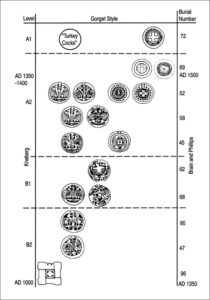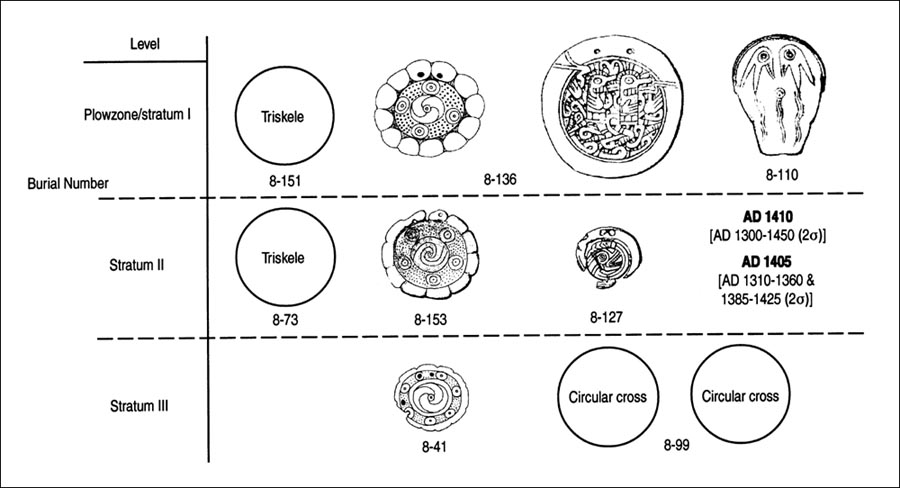by Lynne P. Sullivan, McClung Museum, University of Tennessee
The Southeastern Ceremonial Complex (SECC) is a term used by archaeologists to refer to a suite of artifacts that often includes iconographic imagery or symbols, finely-crafted and exotic materials, and/or connotes high status. SECC objects were used by Native Americans throughout the Southeast during the Mississippian period (ca. AD 1000-1600). The origins of the symbols and the places of manufacture and dates of use of these artifacts in various subregions of the Southeast are debated topics. The following discussion explains how several newly obtained radiocarbon dates are useful for determining the age of the SECC in the Chickamauga Basin.

Figure 1. Kneberg’s gorget seriation with time contexts as proposed by her, Brain, and Phillips (1999).
Engraved marine shell gorgets are one of the most common types of SECC items found in eastern Tennessee. In 1959, Madeline Kneberg, a founder of the McClung Museum, published a typology and chronology for these finely-crafted pendants (Figure 1) (Kneberg, 1959). Radiocarbon dating was new at the time of Kneberg’s publication, so she correlated the gorgets with the then presumed span of Mississippian complexes, from AD 1000 to AD 1750.
The eighteenth-century date now is known to be too recent for SECC artifacts, but there is debate about the beginning date. Brain and Phillips (1999) recently proposed that the SECC postdates AD 1400. In the years since Kneberg’s work, archaeologists have gained a more refined understanding of the Mississippian period in eastern Tennessee. Using this refined knowledge and the new radiocarbon dates from Mississippian sites in the Chickamauga Basin, we now can place Kneberg’s gorget seriation (chronological arrangement) more precisely in time.
Much of Kneberg’s seriation derives from the stratigraphic positioning of gorgets found with burials in the platform mound at the Hixon site in Hamilton County. Like many other such mounds, the Hixon mound was built layer by layer over many years, forming a complex sequence of summits usually with evidence of one or more buildings on each summit. Important to the temporal placement of the Hixon site and its sequence of gorgets are two nearby sites, Davis and Dallas. These sites, all north of present-day Chattanooga on the banks of the Tennessee River, were excavated in the 1930s as part of the WPA [Works Progress Administration] projects done before flooding of TVA’s [Tennessee Valley Authority’s] Chickamauga reservoir (Lewis, Lewis, and Sullivan 1995).
As noted above, archaeologists now know more about changes during the Mississippian period than they did in Kneberg’s day. The currently accepted chronology for eastern Tennessee divides the Mississippian period into the Martin Farm (AD 900-1100), Hiwassee Island (AD 1100-1300), and Dallas (AD 1300-1600), plus Mouse Creek (AD 1400-1600) phases. There are readily recognizable changes in pottery, architecture, and burial practices throughout the period. General trends in pottery attributes are from predominately limestone-tempered to shell-tempered, from loop handles to strap handles, and an increasing amount of decorative treatments. Architectural styles change from wall trench to single-post construction buildings, and burial practices shift from burial mounds, built incrementally by adding individuals over time, to individual pit graves located both in mounds and villages. These changes happen over 600 years, between the tenth and the beginning of the sixteenth centuries.
Many of these changes can be observed in the archaeological evidence from the Davis, Hixon, and Dallas sites. In fact, the evidence indicates that these three sites were sequentially used between ca. AD 1100 and 1450. The Davis site is the earliest in the sequence. This site included one large platform mound, but little evidence of a village. No burials or shell gorgets were found in the mound. The pottery from Davis is consistent with an Early Mississippian context and wall trench buildings occur throughout the mound. Wood charcoal from a hearth just above the initial mound level produced a radiocarbon age of AD 1160 (Note 1). Using an estimate of 15 to 20 years for the average use-span of a platform mound summit (Hally 1999) and the dated layer in the mound as a reference, the Davis mound dates from about AD 1120 to 1200, the early part of the Hiwassee Island phase.
The Hixon site is next in the sequence. It also included one platform mound and little evidence of a village. The pottery from Hixon is a later Hiwassee Island through early Dallas phase assemblage, and from the earliest to the latest mound levels, the buildings change from wall trench to single post construction. Numerous burials found in the lower levels suggest a thirteenth century date, the latter portion of the Hiwassee Island phase. This is the time period when the use of burial mounds ceased, but is before single post buildings became most common. Burials in the upper mound levels are with the single post buildings typical of the Dallas phase.

Figure 2. Stratigraphic profile of the Hixon mound, showing location of dated Floor O.
A radiocarbon assay on a wooden grave covering from a burial interred in Floor O of mound stage B1 (Figure 2) yielded a date of AD 1235 (Note 2), placing this mound level squarely in the Hiwassee Island phase.
Another burial, interred in the same floor, contained a shell gorget with a turkey cock motif. This association links the Hixon mound gorget sequence to absolute time. Using this date as a reference and an estimated 15-20 year use of mound summits, construction of the Hixon mound began just before AD 1200 and ceased in the mid-fourteenth century. These estimates, the pottery, and the architecture all point to a late Hiwassee Island through early Dallas phase context for the Hixon mound and its sequence of gorgets. The original field records show that Kneberg made two errors in assigning gorgets to mound layers, but these do not substantially alter her findings. Figure 3 shows the revised gorget sequence in relation to the mound levels and the radiocarbon date.

Figure 3. Revised gorget seriation in relation to the Hixon mound levels and radiocarbon date.
The Dallas site, the type site for the Dallas phase, had one mound surrounded by a village enclosed by a palisade. Layered deposits found in some areas indicate two Dallas phase occupations of differing time and duration. The mound, palisade, and the majority of the single post-style buildings in the village are associated with the later occupation. Nearly all of the buildings from this last occupation were burned, suggesting that the village burned and was abandoned.
The Dallas site can be bracketed between AD 1350 and 1450, squarely in the phase that bears its name. A charcoal sample from a burned house dated to AD 1410 (Note 3). Another radiocarbon assay on a wooden grave cover produced a date of AD 1405 (Note 4). This burial also was from the later occupation of the site. These dates place the later occupation in the early fifteenth century, which makes the late fourteenth century the likely time period for the earlier occupation. Shell gorgets were with several burials at the Dallas site; six can be assigned to the later occupation (Figure 4: plowzone/stratum I and stratum II), and two to the earlier (figure 4: stratum III). The earlier styles correspond to those in the upper levels of the Hixon mound.

Figure 4. Gorget sequence at the Dallas site.
The sequence of use of the Davis, Dallas, and Hixon sites is thus as follows: Davis, AD 1100–1200; Hixon, AD 1200–1350; and Dallas, AD 1350–1450. The occupations associated with gorgets at these sites concentrate in the thirteenth through early fifteenth centuries. Kneberg’s suggested time span for the gorget sequence certainly is too long, but the late twelfth/early thirteenth century beginning date that fits the archaeological contexts of these artifacts is much earlier than the fifteenth century date proposed by Brain and Phillips (1999).
The sequence of use of the Davis, Hixon, and Dallas sites also brackets the Southeastern Ceremonial Complex. The Davis site has no gorgets or SECC artifacts in the mound; it predates these items. In contrast, the Hixon mound contains many SECC items, including copper headdresses and copper-covered ear plugs, a monolithic axe, Dover chert blades, and shell cups, as well as the large number of gorgets. This site obviously was occupied at the height of use of such objects. Far fewer SECC objects were found at the Dallas site than at Hixon. The Dallas site postdates most of the SECC materials. Based on these sites, the peak of the SECC in the Chickamauga Basin is between AD 1200 and 1400, corresponding to the use-span of the Hixon mound.
Notes
- 900+/-50 BP; cal AD 1020 and 1250 (2sigma) Beta 127866
- 810+/-50 BP; cal AD 1155 to 1285 (2sigma) Beta 128375
- 540+/-60 BP; cal AD 1300 to 1450 (2sigma) Beta 127867
- 560+/-30 BP; cal AD 1310 to 1360 and AD 1385 to 1425 (2sigma) Beta 128660
References Cited
Brain, Jeffrey P. and Philip Phillips. 1999. Shell Gorgets: Styles of the Late Prehistoric and Protohistoric Southeast. Peabody Museum Press, Harvard University, Cambridge, MA.
Hally, David J. 1999. Platform Mound Construction and the Instability of Mississippian Chiefdoms. In Political Structure and Change in the Prehistoric Southeastern United States, J. F. Scarry, ed., pp. 92-127. University Press of Florida, Gainesville.
Kneberg, Madeline D. 1959. Engraved Shell Gorgets and Their Associations. Tennessee Archaeologist 15(1): 1-39.
Lewis, Thomas M. N., Madeline D. Knebert Lewis, and Lynne P. Sullivan, Eds. 1995. The Prehistory of the Chickamauga Basin in Tennessee (2 vols.). The University of Tennessee Press, Knoxville.